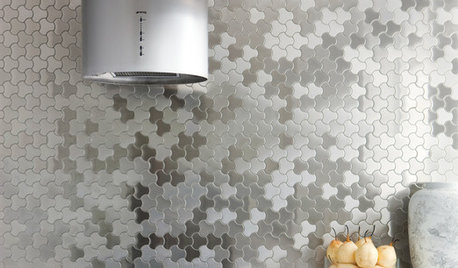Fleck vs Kinetico for well water
sendittogregg
8 years ago
Featured Answer
Comments (25)
sendittogregg
8 years agoRelated Discussions
Culligan HE vs Kinetico Premier vs Fleck
Comments (35)We just bought a home that had an existing Culligan water softener system installed. We had a technician (and yes, you will be married to a Culligan dealer for ANY issues/repairs/service) come out and check to ensure the equipment worked properly and was at the correct setting for our water & our usage. My husband said the guy was in & out before he knew it. The technician told him the equipment was working fine. He never even checked our water quality which cough, cough I'm not sure why hubby didn't insist it be done. We used to have well water & a very good softener years ago, and we never had the issues we have with using this Culligan system. I taste salt in the water, our faucets all have white scale on them, 3 months into moving here our brand new fridge ice maker doesn't work, toilets are lined with orange, our white laundry is dingy and my daughter & I use tons! of shampoo and soap in the shower and our skin is not soft at all. My husband adjusted the ? I'm not sure what to try to correct, but I'm not even sure he's done it right. Hate to call the technician again and get their $250 charge for nothing. Wish I could remember the brand of the old unit we had. After reading several sites, I am leaning towards the Fleck brand. But, like other readers have stated, it's not about the cost of the unit initially, it's more important to LOVE our water!...See MoreKinetico water softener overpriced?! Need suggestions....
Comments (22)Jake, I agree with you totally as far as overdoing with home water treatment. I took the Kinetico bait, hook, line and sinker. I wanted to make sure my water was safe, but I am on domestic water that meets or exceeds all federal standards and the Kinetico system was way overkill. That is my point. If you have a Kinetico salesman test your water, you will be told you need a Kinetico system and they are way overpriced as far us purchase price and long term costs. My experience with the K5 and Kinetico water softener I installed in 7/2012 started with a kiosk at Home Depot. I sent in a water sample and of course I was told I had hard water and would benefit greatly from a K5 and if I buy a Kinetico water softener at the same time, I get a 10 year warranty. We know how that story goes. It can be helpful to have a water softener and maybe you need a water filter at the sink for drinking water. The point is to have your water tested by someone who does not profit from selling you something. It is required for domestic water to be tested and to meet federal guidelines, and it is free to find out the results of the testing by the local domestic water provider. Once you learn about your water from an independent source, then do your own research to find out what you need, if anything, to clean up that source to your liking. The plumber I hired is from our local area and knows our water test results. He is familiar with the 3M system, which more than handles our water purification needs. I reviewed multiple Amazon verified purchaser reviews for the 3M system before purchasing. It is not perfect, but it is a reliable system that is user friendly. There are no Amazon reviews for Kinetico water softeners or K5s because of the proprietary Kinetico marketing scheme that locks the consumer in to one dealer that charges whatever they want to service the overpriced Kinetico system. The Kinetico dealer lives 2.5 hours away and knew nothing about the local water test results, but he did know how to recommend a $5000 Kinetico system, which I purchased. Unfortunately I learned that Kinetico is all about the sales and not about the follow up customer. service. Lesson learned about people's expertise online. None of us know each other and I assume that AIW and Jake are actually different people, but there is no way I have to prove that. We have to trust each other somewhat and online communication makes it easy to hide behind fake names and multiple personas. Bottom line is buyer beware. If it sounds too good to be true it probably is, and there is no such thing as a free lunch....See MoreKinetico RO VS Pure Blue H20 RO
Comments (1)Both RO units use proprietary filters so both will be more expensive to maintain than one that uses industry standard filters. The K5 is a better unit. However, $2000 is a very steep price for an RO unit, particularly when you are unlikely to notice any meaningful difference between the two....See MoreFleck Water Softener Valve w/ Upflow, Variable Brine, Double Backwash?
Comments (14)Alice, thank you for all of the detailed information. I currently have a dual tank Kinetico Model 60 that is 17 years old and needs new resin but since it is a proprietary system the local dealer wants $600 to replace the resin. Would you recommend replacing the resin or purchasing a new Fleck 5600sxt which would not be much more expensive? FYI for those who made be reading this, I have come to the following conclusions based upon my research: 1. Fleck appears to be the most recommended and companies like 602ABCWater provides a 5600sxt with the 10% cross-linked resin. There are more Fleck water softener systems on the internet because the distributors/re-sellers are not limited to a territory and can sell from anywhere to anywhere in the US. 2. Clack distributors/re-sellers cannot sell outside of their territory so there are fewer internet/web offerings. Reduced competition appears to cause the Clack systems to have a higher price than the Fleck systems. 3. Hydrotech / Canature appears to be the primary provider for many of the private brand valves/controllers including the Discount Water Softeners-Genesis, the US Water Systems- Fusion NLT and the Quality Water Treatment-SoftPro. All three of these companies quote the same statistics that promote the "efficiencies" and "cost savings" of an Upflow system vs a Downflow system. These companies also offer a 10 year warranty on the controller compared to 5 years for the Fleck but reading other blogs, it would appear that a Fleck controller can last 15 or more years which would probably outlast your resin....See Moresendittogregg
8 years agosendittogregg
8 years agosendittogregg
8 years agosendittogregg
8 years agolast modified: 8 years agosendittogregg
8 years agosendittogregg
8 years agosendittogregg
8 years agosendittogregg
8 years agolast modified: 8 years agosendittogregg
8 years agosendittogregg
8 years agoUser
6 years ago
Related Stories

HEALTHY HOMEHow to Choose a Home Water Filtering System
Learn which water purification method is best for your house, from pitchers to whole-house setups
Full Story
KITCHEN COUNTERTOPS10 Great Backsplashes to Pair With Stainless Steel Counters
Simplify your decision-making with these ideas for materials that work well with stainless steel counters
Full Story
DECORATING GUIDESHow to Use Mirrors for More Light and Style
A well-placed mirror gives a room sparkle, surprise and a bright, open feeling. Here are 15 clever ideas to try in your own house
Full Story
KITCHEN DESIGNKitchen Counters: Stunning, Easy-Care Engineered Quartz
There's a lot to like about this durable blend of quartz and resin for kitchen countertops, and the downsides are minimal
Full Story
DECORATING GUIDESBling Where It’s Least Expected
Give your interior some sparkle and shine with metal tiles on a backsplash, shower or floor
Full Story
KITCHEN COUNTERTOPS10 Top Backsplashes to Pair With Soapstone Countertops
Simplify your decision-making process by checking out how these styles work with soapstone
Full Story
KITCHEN COUNTERTOPS7 Low-Maintenance Countertops for Your Dream Kitchen
Fingerprints, stains, resealing requirements ... who needs ’em? These countertop materials look great with little effort
Full Story
KITCHEN DESIGNHouzz Quiz: Which Kitchen Backsplash Material Is Right for You?
With so many options available, see if we can help you narrow down the selection
Full Story
MIDCENTURY HOMESHouzz Tour: An Eichler Remodel Spawns a Design Career
A homeowner finds her true calling upon redesigning her family's entire California home
Full Story
COLORTake Rooms on a Tropical Trip With Turquoise and Yellow
Flee winter's doldrums with a virtual island paradise at home, courtesy of sea-drenched and sunshiny colors
Full StorySponsored
Central Ohio's Trusted Home Remodeler Specializing in Kitchens & Baths




User